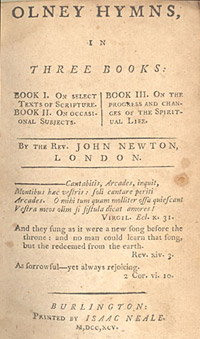|
Digital
History>eXplorations>Spirituals>Amazing
Grace>The Dissemination of Amazing Grace
The Dissemination of "Amazing Grace"
NOTE: This information is reproduced from an article at the Library
of Congress
http://lcweb2.loc.gov/diglib/ihas/loc.natlib.ihas.200149085/default.html
 |
John Newton. Olney Hymns in
Three Books. Burlington [VT]: Isaac Neale, 1795. Rare Book
and Special Collections Division. John Newton wrote the
words to "Amazing Grace" in 1772. It was not
for another 60 years that the text was wed to the tune
to which it is sung today.
Olney Hymns in Three Books was published in London in
1779, containing only the words to hymns that were linked
to specific sermon themes and Biblical references. The
publication of hymns in this fashion--that is, without
specific melodies and accompaniments--was commonplace in
Newton's day. Each congregation adapted the words to well-known
songs or hymn melodies whose musical rhythms matched the
poetic meter of the text. [ 1 ] It is
easy to see, for example, how "Amazing grace! (how
sweet the sound)" can be sung to the same tune as
the words of another popular hymn, "There is a land
of pure delight."
Authors such as Newton who published hymnals with text
only were able to stress the importance of the ideas and
themes that their poems expressed. Also, on a practical
level, these hymnals were far more economical to publish
and sell because the process of printing music bore additional
costs.
After debuting in Olney Hymns, "Amazing Grace" soon
appeared in other hymn collections in England, but it flourished
in America. In 1789, just ten years after its first publication,
it was included in a Reformed Dutch Church hymnal in New
York. |
| John Newton. Olney Hymns in Three Books.
Burlington [VT]: Isaac Neale, 1795. Rare Book and Special
Collections Division. |
The following year, Newton's Olney Hymns was published in New
York, the subsequent year in Philadelphia and in 1795 in New
Jersey. The Baptists next issued the text in Hymns and Spiritual
Songs, published in Virginia, in 1793.
"Americans took the song into their hearts," wrote
Steve Turner in his chronicle of the hymn's history. [ 2 ] Americans
added further stanzas to Newton's poem and eventually set it
to the simple, accessible melody by which it is now known throughout
the world.
By the early 19th century, the Reform, Baptist, and Congregationalist
churches in America were among those that had adopted "Amazing
Grace" into their worship service. This interdenominational
appeal, Turner notes, may well have been the result of the hymn's
popularity during the Great Awakening of the 1820s and 1830s,
a widespread religious movement that found its greatest expression
in camp revival meetings. Further dissemination came when the
song was published in shape-note hymnals.
Once Newton's text became linked to a notated tune, the emphasis
shifted from the words to its music. This specific tune, known
as "Harmony Grove," also was employed for "There
is a land of pure delight," the hymn text cited above.
The melody for "Amazing Grace" is based on the pentatonic
or five-note scale (heard by striking the five black notes on
a piano); in fact, in its earliest form, the melody employed
only these five pitches. Refinements to the tune are attributed
to William Walker, who in 1835 entitled it "New Britain" and
published it in a book of hymns entitled The Southern Harmony.
This collection was reprinted four times during Walker's lifetime;
it sold an estimated 600,000 copies. By the Civil War, as Turner
notes, "Amazing Grace" was a vital part of American
life." [ 3 ]
Although Newton's poem on its own speaks masterfully of the
soul's journey to salvation, it found its most powerful expression
when set to Walker's elegant and simple hymn tune. From the pen
of a curate in the English countryside, "Amazing Grace" became
a beloved anthem expressing personal and communal optimism, fulfillment,
and deliverance.
NOTES:
1. Hymns were (and still are) known by two
titles: one, the first line of their texts and two, the name
of the hymn tune
to which the text is sung. Hence, one tune serve for a number
of texts.
2. Amazing Grace (New York: HarperCollins,
2002), 114.
3. Ibid. 126.
|
